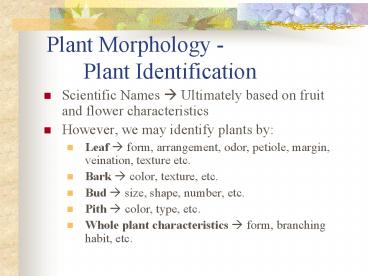Plant Morphology - Plant Identification - PowerPoint PPT Presentation
1 / 32
Title:
Plant Morphology - Plant Identification
Description:
Plant Morphology - Plant Identification Scientific Names Ultimately based on fruit and flower characteristics However, we may identify plants by: – PowerPoint PPT presentation
Number of Views:1979
Avg rating:3.0/5.0
Title: Plant Morphology - Plant Identification
1
Plant Morphology - Plant Identification
- Scientific Names ? Ultimately based on fruit and
flower characteristics - However, we may identify plants by
- Leaf ? form, arrangement, odor, petiole, margin,
veination, texture etc. - Bark ? color, texture, etc.
- Bud ? size, shape, number, etc.
- Pith ? color, type, etc.
- Whole plant characteristics ? form, branching
habit, etc.
2
Plant Morphology - Plant Identification
- Bud - A compressed, undeveloped shoot. Buds may
be lateral or terminal. - Node - point on the stem where leaf or bud is
borne. The space between two nodes is an
internode - Lenticel - a "breathing pore" in the skin or bark
of a stem.
3
Plant Morphology - Plant Identification
- Pith - the spongey tissue in the center of a stem
or twig. Pith can be solid, chambered, or
diaphragmmed.
4
Plant Morphology - Plant Identification
- Pith - the spongey tissue in the center of a stem
or twig. Pith can be solid, chambered, or
diaphragmmed.
5
Plant Morphology - Plant Identification
- Simple Leaf
- Petiole - the stalk of a leaf a leaf without a
petiole is sessile - Blade - the flat, expanded portion of the leaf
6
Plant Morphology - Plant Identification
- Simple leaf
- Stipule - flat, often leaf-like flap below a
leaf. Not all leaves have stipules. Stipules can
be highly modified into tendrils, spines, scales,
ect. - Axillary bud - the bud in the axil - the angle
between the leaf and stem.
7
Plant Morphology - Plant Identification
- Leaf arrangement
- Alternate - leaves
- arranged one per node
8
Plant Morphology - Plant Identification
- Leaf arrangement
- Opposite - leaves
- arranged two per node
9
Plant Morphology - Plant Identification
- Leaf arrangement
- Whorled - arranged two
- or more per node
10
Plant Morphology - Plant Identification
- Leaf arrangement
- Fascicled - leaves grouped in small, tight bundles
11
Plant Morphology - Plant Identification
- Simple and compound leaves
- Simple - the blade is all in one piece, though it
may be lobed, toothed, etc.
Helpful Hint In trying to decide where a leaf
begins, look for the axillary bud. Everything
above the axillary bud is all one leaf.
12
Plant Morphology - Plant Identification
- Simple and compound leaves
- Compound - the blade is divided all the way to
the midrib (rachis) into two or more pieces.
13
Plant Morphology - Plant Identification
- Compound leaves
- Once pinnately compound - leaflets arranged along
one undivided main axis. (odd or even number of
leaflets)
14
Plant Morphology - Plant Identification
- Compound leaves
- Twice pinnately compound - main axis (rachis)
with two or more branches and the leaflets
arranged along the branches. The branch divisions
are primary leaflets and the ultimate divisions
are secondary leaflets. There can also be
thrice-pinnately compound leaves,etc.
15
Plant Morphology - Plant Identification
- Compound leaves
- Palmately compound -leaflets all arising from one
point at the base of the leaf.
16
Plant Morphology - Plant Identification
- Leaf veination
- Pinnate - with a main midvein and secondary veins
arising from it at intervals
17
Plant Morphology - Plant Identification
- Leaf veination
- Palmate - with the main veins all arising from
one point at the base of the leaf.
18
Plant Morphology - Plant Identification
- Leaf veination
- Parallel - with all the main veins parallel
(usually also parallel to the sides of the leaf.)
19
Plant Morphology - Plant Identification
- Leaf veination
- Dichotomous - with each vein branching in two
again and again (e.g. Ginkgo)
20
Plant Morphology - Plant Identification
- Leaf lobing
- Pinnately lobed - with the lobes arising along
the length of the mid-line of the leaf. - Palmately lobed - with the lobes all arising from
one point at the base of the leaf.
21
Plant Morphology - Plant Identification
- Leaf shapes
- Ovate - egg-shaped with the larger end at the
bottom. - Elliptic - shaped like an ellipse, tapered at
both ends and with curved sides.
22
Plant Morphology - Plant Identification
- Leaf shapes
- Oblong - tapered to both ends, but with the sides
more or less parallel. - Lanceolate - shaped like the tip of a lance,
broadest at the base and tapered to a long point.
23
Plant Morphology - Plant Identification
- Leaf shapes
- Linear - very long and thin, with the sides
parallel - Cordate - heart-shaped with the wide part at the
bottom
24
Plant Morphology - Plant Identification
- Leaf margins
- Entire - smooth, with no teeth or lobes
25
Plant Morphology - Plant Identification
- Leaf margins
- Serrate - with sharp, forward-pointing teeth
26
Plant Morphology - Plant Identification
- Leaf margins
- Doubly serrate - with teeth which have smaller
teeth on them
27
Plant Morphology - Plant Identification
- Leaf margins
- Serrulate - with very tiny sharp teeth
28
Plant Morphology - Plant Identification
- Leaf margins
- Dentate - with teeth which point outwards
29
Plant Morphology - Plant Identification
- Leaf margins
- Crenate - with low, rounded scallop-like teeth
30
Plant Morphology - Plant Identification
- Leaf margins
- Undulate - waving up and down
31
Plant Morphology - Plant Identification
- Leaf margins
- Revolute - turned under
32
Plant Morphology - Plant Identification
- Leaf margins
- Lobed, parted, divided, cut, etc. - A number of
terms describe the various degrees of lobing.































